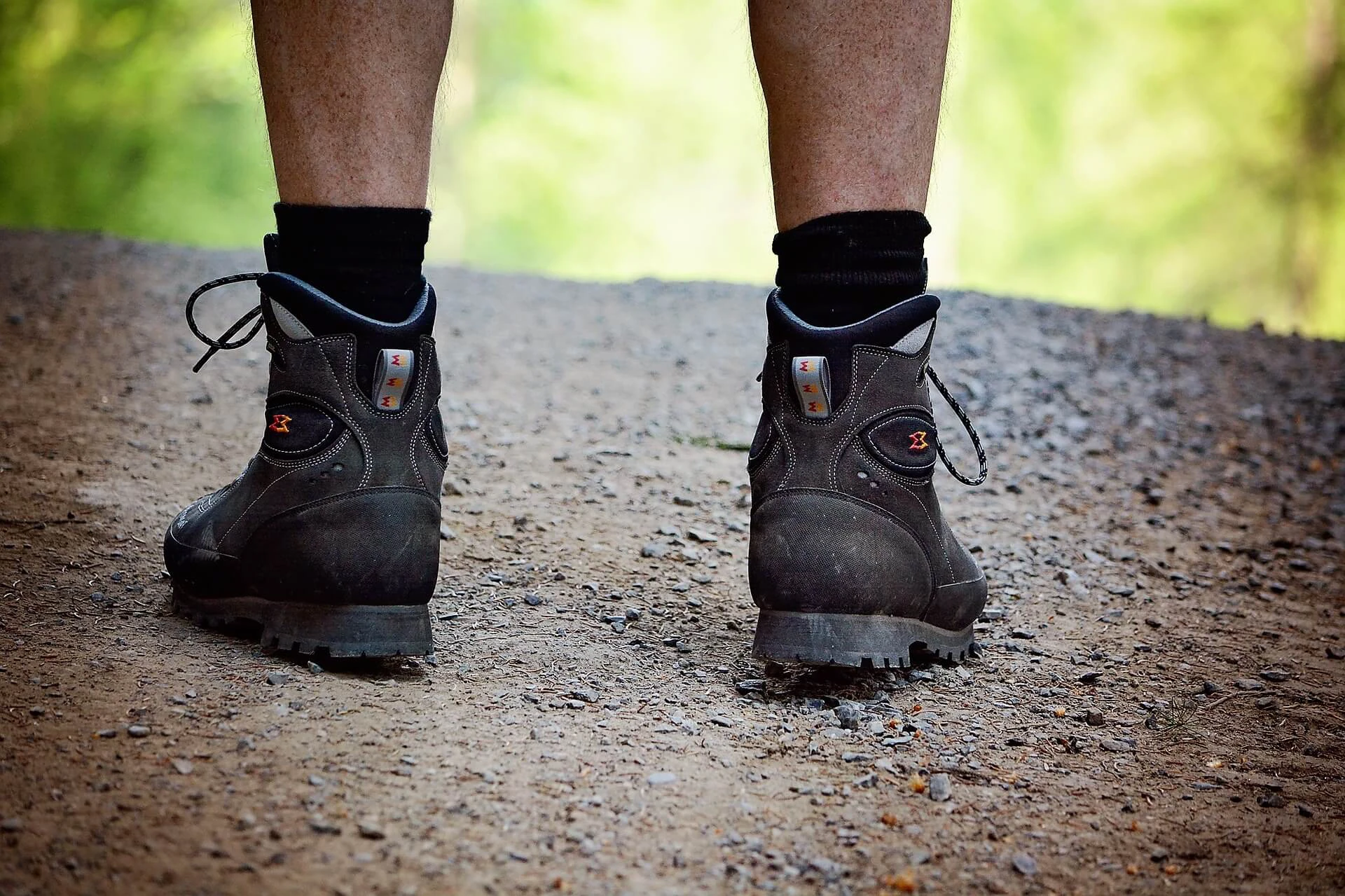So you can enjoy your hiking boots for a long time

Whether leisurely hiking trails, through the undergrowth of green forests or cross-country. The right footwear is indispensable for extensive hiking tours, for example through the breathtaking beauty of the land of maars and volcanoes. So that you can enjoy your shoes for a long time, we'll tell you four tips on how to properly care for your hiking shoes.
Properly care for hiking boots: tips and tricks
In order to make hiking fun in all weather conditions and in every terrain of the GesundLand Vulkaneifel, a well-fitting hiking boot is essential. And once you've put them on, you won't want to give them up so quickly.
Even simple care tricks help to ensure that your beloved hiking boot stays with you for as long as possible.
Tip 1: Let it air out well - even on tours
Stinky boots - no thanks? To avoid unpleasant odors, always air out your hiking boots well. Be sure to take out the insole and lay it down separately to air it out, because it absorbs the most moisture.
Tip: It's best to replace the insole of your hiking boots with custom orthopedic insoles to prevent foot pain on long hikes and avoid secondary damage caused by incorrect stress. These custom insoles are of course also available as breathable sports insoles. But you should also let them air out well!
Tip 2: Clean regularly - step-by-step instructions
To preserve not only the material but also the appearance of the hiking shoe, conscientious cleaning is important. Cleaning shoes sounds more elaborate than it actually is: in three steps the shoe is as good as new.
It doesn't matter whether your hiking boot is made of smooth, suede, nubuck leather or Gore-Tex. However, it's best to remove the laces and insole before cleaning. That way you can get to all surfaces easily.
Step 1 - Brush off coarse dirt
First, it is important to get the coarse dirt off the sole and the outside. Knock off the dry dirt and help with a coarse shoe brush - also under the laces.
Important: Remove the coarse dirt as soon as possible after a tour, so it does not settle too much. You can also pack a small brush in your backpack or car so that you don't take the dirt into the interior of your vehicle or room in the first place.
Step 2 - Clean inside and outside with gentle washing solution
Once the coarse dirt has been removed from the outside, the washing solution comes into play. Make sure to use mild soap or a gentle detergent or lukewarm water.
If the water in your area is very chalky, you can also use distilled water to avoid unsightly stains.
Go over the inside and outside of the shoe with a soft brush or sponge. You should be careful with the inner material, otherwise you could damage the membranes that make the shoe breathable and water-repellent. Also the shoe laces and the inner sole can be cleaned in the washing solution or even the washing machine.
Then rinse the shoe with fresh, lukewarm water so that no soap residues remain. Important: Never use bleach or other aggressive detergents for cleaning, so as not to damage the material!
Step 3 - Drying
After washing, it is time to dry the shoes thoroughly. The best way to do this is to place your shoes with the opening facing downwards in a place with dry air (e.g. a boiler room) or outside.
Caution: Never place your hiking boots directly on the stove, on the heater or in the blazing sun. This can cause the material to become brittle and the glued joints to come loose. This does more harm than good.
To make them dry faster, you can also stuff the shoes with newspaper or kitchen roll. But remember to change the paper regularly. Boot bananas or shoe cushions also help with drying. A shoe tree also keeps the hiking shoes in their shape.
Tip 3: The right care for leather and Gore-Tex hiking boots
Now that the hiking boots shine beautifully, the only thing missing is the right care. No matter whether they are made of leather or Gore-Tex: Impregnation is the magic word.
Newly purchased shoes usually do not need to be impregnated, but it does not hurt either. You can find out here what advantages Gore-Tex and leather offer for hiking boots.
Leather hiking boots care
To care for leather hiking boots, you need the right care product. Wax is the best product of choice here. As a wax cream or emulsion, it optimally cares for the leather and maintains its longevity.
Grease, on the other hand, would tend to close the pores. It makes the shoes waterproof - but at the same time impermeable to air. Thus, the hiking boot quickly becomes an undesirable rubber boot.
Oil is also not a good care product for leather shoes, because it softens the material, but it makes the shoe lose its shape too much. Wax, on the other hand, remains on the surface, keeps the shoe in shape, makes it waterproof and does not gum up the pores.
How it works: Apply the leather care to the outside of the shoe and work it in with a soft brush or cloth. Do not forget the tongues and lugs! Be careful not to use too much wax and polish with a clean cloth.
Care Gore-Tex hiking boots
For synthetic hiking boots, you should use a suitable waterproofing spray or liquid waterproofing for care. Simply spray this onto the outside of the shoe and rub in with a cloth. Also treat the tongues and lugs.
Care hiking boots nubuck or suede leather
Hiking boots made of nubuck or suede leather can be impregnated with a shoe wax, just like normal leather hiking boots. After applying and massaging in the product, you can roughen the leather with a coarse brush to restore the look.
Care goat sewn hiking boots
If you have traditional hiking boots with a double seam, you need to take extra good care of them. It is important to apply shoe wax directly to the inside and outside of the seam. Keep an eye on the condition of the seam and maintain it regularly to keep the shoe durable.
In this video you will find all the cleaning tips summarized again in a compact guide.
Extra tip: By the way, the hooks and eyes can be treated with petroleum jelly or wax to protect them from corrosion.
Tip 4: Store hiking boots correctly
Before storing the shoes, make sure that they are really dry. In the worst case, otherwise not only bad odors, but also mold can form!
After cleaning and impregnating, don't forget to put the shoe laces and insole back on or in your hiking boots.
If you want to store the shoes over the winter - perhaps to wait for the next summer in the GesundLand Vulkaneifel - it is best to store them in a shoe box or bag in a dry, well-ventilated room. To prevent them from losing their shape, you can stuff them with newspaper or use a shoe tree.
Why do I need to take care of my walking shoes?
If you care for your hiking boots regularly - at least after every tour - you will increase the lifespan of your boots and they will remain breathable or waterproof.
By the way, with waterproof shoes you avoid the risk of blisters on the feet, because: Wetness inside softens the skin and thus promotes the formation of blisters.
How often do I need to care for my hiking boots?
A rough guide is approximately after 5-8 tours at the latest or as soon as the material feels dry. The coarse dirt, however, you should remove after each hike to protect the material.
How long do high-quality hiking boots usually last?
How long the hiking boots last, of course, depends largely on the use and care. Pi times thumb with good quality but at least 1,000 to 1,300 kilometers.
By the way, the sole wears out the fastest and should therefore be checked regularly. Avoidable dangers can arise: Without sufficient tread, grip on slippery surfaces is lacking and walking comfort is massively impaired!
Tip: Especially with high-quality, expensive hiking boots, it is worth having them replaced after a certain amount of wear. The insole is also a wearing part that should be changed regularly or replaced with removable orthopedic insoles.
In any case, if you take these tips to heart, nothing will stand in the way of new hiking adventures around the fantastic landscapes of the Volcanic Eifel! 🙂
Author: Lukas Köb
By submitting the form, you agree to our privacy policy.


